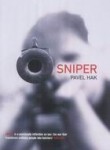“Sniper,” a novel by Pavel Hak

Sniper; a novel by Pavel Hak. Editions Tristram, 2002. Trans. 2005 by Gerry Feehily, 121pp $14.00 paperback. ISBN 1-852-42856-2
A review by Eric Solomon
This short (121 small pages) “war novel” needs genre classification. Brief war novels are not anomalies: Tolstoy’s Sebastapol, Crane’s The Red Badge of Courage, March’s Company K are quick examinations of battle’s grim horrors. Pavel Hak follows a pattern of eschewing character development and plot creation to concentrate on terror in the tradition of Holocaust narrative. The unwary reader of Sniper, however, is unprepared for the consistent barrage of megadeath. A review might employ the old Reader’s Digest formula: “reading time, one hour”; or alas, a simpler response: “de Sade meets genocide.” The ultimate defining tone, the novel’s resonance, the vital center, seems mostly to labor under the label of pornography, which, of course, is war’s, particularly civil war’s, tempting characteristic.
The subject is killing. Horrible killing; killing coldly yet in ghastly detail. One can tease out of the slaughters of Kosovo-type innocents three basic death bringers to the innocent victims, a few of whom resist and may escape by becoming killers themselves.
Killing human beings comes in every form, on almost every page. Since there are no “characters” in a traditional sense, the reader must tease out the three main slaughterers, among the uncounted masses of the slaughtered. Oversimplifying, we find types of murdered: “fugitives,” casual bystanders, ethnic, religious, helpless or resisters. The main motives for the murderers are “the State,” revenge, survival.
The first-person, pure killer, point-of-view figure is the sniper himself, with the most objectified approach. “War doesn’t allow for questions, dissidents, fleeing men and women, enemy soldiers, children, the old…my target! To deal a lethal blow. To kill” (1). He is an icy extension of his rifle, his cause is the state, his victims are guilty of speaking, which complicates: “There’s a war on because of too many babbling mouths…He who accepts order and abides by the law can never be the cause of evil” (2). He has the first and the last words of the 29 short sections of the book, his own hero as “THE MONSTER OF INHUMANITY” (121), who never misses his (mostly random) targets and can only be defeated by lack of ammunition.
The second narrative view is more widely focused on countless (for the reader resists enumeration) of women victims of soldiers’ violent, lustful rapes, tortures, dismemberments, death-and rebellion. A few potential victims survive to become “fugitive” killers themselves throughout the text-and/ or are atrociously killed; they are joined with some men who help kill in revenge on their way to a border.
Then there is another individual who counterpoints the brief vignettes of disaster: a man with an axe who is first seen trying to cut through the ice to uncover the corpses of his entire murdered family. He too becomes a textual fugitive, seeking to carry his macabre burden of dead to some appropriate burial…and will become, presumably, the sniper’s final victim.
Why pornographic? The tone of gross dismemberment by torture is too savage, too orgasmic. Or perhaps the constant, unrelieved anti-sexuality becomes so anti-sentimental as to become faux sentimentalizing of terror. In sum, this novella is an horrific reading experience, so much so that it distances by overstressing its anti-war theme. Perhaps an alternative title might be What Hitler Dreamed or Slaughterhouse 500, 5000, 50,000. Sniper‘s victims could have been painted by Francis Bacon; like Macbeth immersed in imagined rivers of blood, Hak has “Stepp’ in so far that, should [he] wade no more,/ Returning were as tedious as go o’er.”
About the reviewer
Eric Solomon has served San Francisco State University as Provost and head of the libraries, among many other offices. Emeritus Professor of English, he has taught and written about literature for more than 50 years. He started his career with a dissertation on nineteenth-century British and American war fiction. Solomon is probably best known for his foundational books on Stephen Crane and the Civil War: Stephen Crane in England, Stephen Crane: From Parody to Realism, and Civil War Fiction — The Faded Banners, an anthology of Civil War fiction. (“It had a great cover,” he remarks.) He has published a variety of pieces directly on war fiction, especially the fiction of Thackeray, Twain, Kipling, Bierce. He thought the best of them may be the piece on Heller and Faulkner called “Christ in Flanders.” We’ve asked him for a copy so we can scan it and link to it. –Eds.